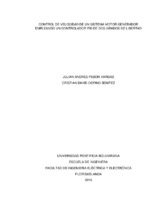Mostrar el registro sencillo del ítem
Control de velocidad de un sistema motor generador empleando un controlador pid de dos grados de libertad
| dc.contributor.advisor | Silva, Luis Ángel | |
| dc.contributor.author | Pabón Vargas, Julián Andrés | |
| dc.contributor.author | Ospino Benítez, Cristian David | |
| dc.coverage.temporal | 2019 | |
| dc.date.accessioned | 2021-01-18T20:31:31Z | |
| dc.date.available | 2021-01-18T20:31:31Z | |
| dc.date.issued | 2019 | |
| dc.identifier.uri | http://hdl.handle.net/20.500.11912/7388 | |
| dc.description | 79 páginas | spa |
| dc.description.abstract | En este proyecto se presenta la implementación de un sistema de control de velocidad empleando un controlador PID de dos grados de libertad (PID-2DOF) para un sistema motor-generador. Inicialmente se presenta la estrategia de control PID general y la estrategia PID-2DOF junto con el método de sintonización por IMC. Posteriormente, se realiza la identificación del sistema motor-generador empleando una trayectoria escalonada como señal de referencia. El envío y adquisición de datos se realiza mediante una tarjeta Arduino UNO junto con la herramienta Simulink de Matlab. A partir de los datos obtenidos se realiza la identificación del modelo lineal del sistema motor-generador utilizando la herramienta IDENT de Matlab. Al obtener el modelo matemático del sistema, se procede a diseñar los controladores PID-1DOF y PID-2DOF usando el método de sintonización IMC. Posteriormente se discretizan los controladores PID-1DOF y PID-2DOF por medio del método de diferencia atrás y aplicando la técnica antiwindup back calculation. La implementación se realiza de forma simulada utilizando la herramienta StateFlow de Matlab y de forma práctica por medio de un PLC. Luego, se evalúa el desempeño de los dos controladores ante la presencia de una perturbación en la entrada del sistema, presencia de ruido de medida y una carga resistiva en la salida del generador. Finalmente, se realiza un contraste cuantitativo comparando los índices de desempeño de cada controlador en las distintas pruebas. Los resultados indican que el controlador PID-2DOF presenta un mejor desempeño al realizar el seguimiento de trayectorias comparado con el controlador PID-1DOF. | spa |
| dc.description.abstract | This project presents the implementation of a speed control system using a PID controller with two degrees of freedom (PID-2DOF) for a motor-generator system. Initially, the general PID control strategy and the PID-2DOF strategy are presented together with the IMC tuning method. Subsequently, the identification of the motor-generator system is made using a stepped path as a reference signal. The sending and acquisition of data is done through an Arduino UNO card together with the Matlab Simulink tool. The identification of the linear model of the motor-generator system using the IDENT tool of Matlab is made from the data obtained. After obtaining the mathematical model of the system, it is proceeded to design the PID-1DOF and PID-2DOF controllers using the IMC tuning method. Subsequently, the PID-1DOF and PID-2DOF controllers are discretized by means of the difference method behind and applying the Anti wind-up back calculation technique. The implementation is done in a simulated way using the Matlab StateFlow tool and in a practical way by means of a PLC. Then, the performance of the two controllers is evaluated in the presence of a disturbance in the input of the system, the presence of measurement noise and a resistive load in the output of the generator. Finally, a quantitative contrast is made comparing the performance index of each controller in the different tests. The results indicate that the PID-2DOF controller presents a better performance when tracking paths compared to the PID-1DOF controller. | eng |
| dc.format.mimetype | application/pdf | |
| dc.language.iso | spa | |
| dc.publisher | Universidad Pontificia Bolivariana | spa |
| dc.rights | Attribution-NonCommercial-NoDerivatives 4.0 International | * |
| dc.rights.uri | http://creativecommons.org/licenses/by-nc-nd/4.0/ | * |
| dc.subject | Reguladores eléctricos | spa |
| dc.subject | Motores generadores | spa |
| dc.subject | Simulink - Software de programación | spa |
| dc.subject | MATLAB (Programas para computadores) | spa |
| dc.title | Control de velocidad de un sistema motor generador empleando un controlador pid de dos grados de libertad | spa |
| dc.type | Trabajo de grado | spa |
| dc.publisher.department | Escuela de Ingenierías | spa |
| dc.publisher.program | Ingeniería Electrónica | spa |
| dc.type.hasVersion | publishedVersion | spa |
| dc.description.sectional | Bucaramanga | spa |
| dc.description.degreename | Ingeniero Electrónico | spa |
Ficheros en el ítem
Este ítem aparece en la(s) siguiente(s) colección(ones)
-
Trabajos de grado [6688]
Monografías, artículos, informes, proyecto de grado


